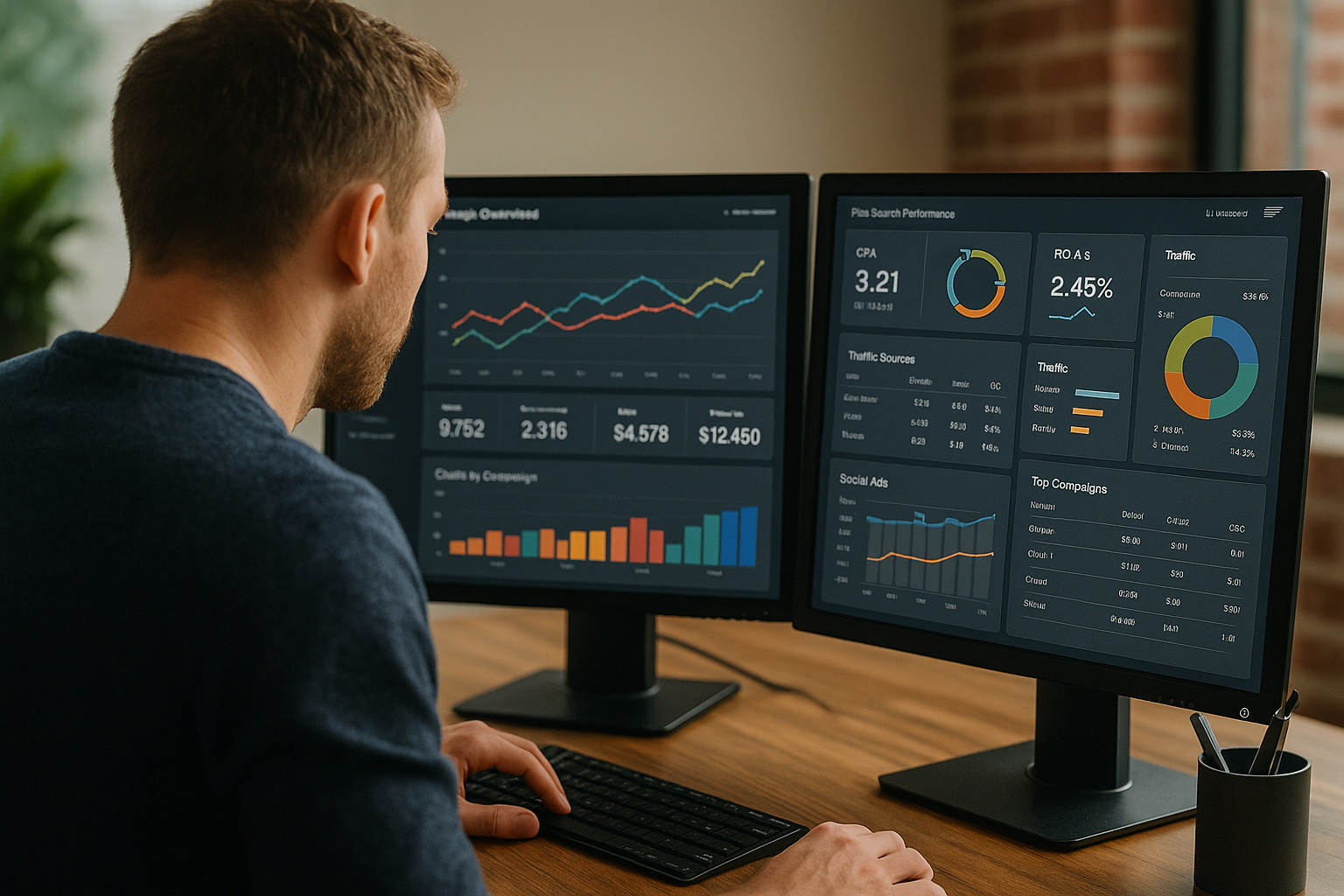Running paid campaigns is only half the job of a traffic manager. The other half — the part that actually improves results over time — is tracking and optimization.
In this article, we’ll explore the essential tools every traffic manager needs to track performance, gather insights, and optimize campaigns for better ROI. Whether you’re managing Facebook, Instagram, Google, or TikTok Ads, this guide will help you become more efficient, accurate, and results-driven.
Why Tracking and Optimization Are Crucial
You can’t improve what you don’t measure. Without proper tracking:
- You won’t know where your results are coming from
- You’ll struggle to scale what works
- Clients will lose confidence due to unclear reporting
Optimization helps you:
- Lower ad costs
- Improve conversion rates
- Test new strategies based on data
- Deliver better results consistently
Let’s explore the key tools you need to succeed.
1. Meta Ads Manager (Facebook & Instagram)
What it does:
This is the control panel for running and tracking ads on Facebook, Instagram, Messenger, and the Audience Network.
Key features:
- See real-time campaign performance
- Break down results by placement, age, device, etc.
- Create custom and lookalike audiences
- Use the Events Manager to track conversions
Optimization tip:
Use A/B Testing and Breakdown Reports to compare performance and spot patterns.
2. Google Ads Dashboard
What it does:
Manage campaigns across Search, Display, Shopping, and YouTube.
Key features:
- Keyword performance tracking
- Quality score breakdown
- Conversion tracking setup
- Custom columns and reports
Optimization tip:
Use negative keywords and adjust bids by device/location for better targeting.
3. Google Analytics 4 (GA4)
What it does:
Tracks what users do after they click your ad — on your website or landing page.
Key features:
- Traffic source analysis
- Conversion paths
- Time on page, bounce rate
- Event-based tracking (like button clicks or form fills)
Optimization tip:
Use GA4 to see if your traffic is converting beyond the ad platform.
4. Google Tag Manager (GTM)
What it does:
A container system to install and manage tracking codes (tags) without editing website code directly.
Use it for:
- Facebook Pixel
- Google Analytics events
- Google Ads conversion tags
- TikTok Pixel
- Custom HTML scripts
Optimization tip:
Use triggers and variables to fire tags only when specific actions occur (e.g., successful form submission).
5. Meta Pixel (Now via Events Manager)
What it does:
Tracks user behavior after interacting with Meta ads.
Events to track:
- Page views
- Add to cart
- Initiate checkout
- Purchase
- Custom events (like scroll or time spent)
Optimization tip:
Set up Custom Conversions to optimize for deeper funnel actions.
6. Looker Studio (formerly Google Data Studio)
What it does:
Allows you to create custom visual reports using data from:
- Google Ads
- Meta Ads (via connectors)
- Google Analytics
- Google Sheets
Why it’s great:
- Combine multiple data sources
- Make client reports visual and easy to understand
- Automate monthly updates
Optimization tip:
Build dashboards with KPIs to track trends week over week.
7. Hotjar or Microsoft Clarity
What they do:
Provide heatmaps, scroll maps, and session recordings to see how users interact with your landing pages.
Use them to:
- Spot page elements users ignore
- See where visitors drop off
- Understand behavior before/after clicking your ad
Optimization tip:
Use recordings to improve landing page layout and CTA visibility.
8. A/B Testing Tools (Built-in or External)
What it does:
Helps you run structured experiments — one variable at a time.
Examples:
- Meta Ads Manager A/B Test tool
- Google Ads Experiments
- Google Optimize (until sunset)
- VWO or Unbounce for landing page split tests
What to test:
- Headlines
- CTA buttons
- Audience segments
- Images/videos
- Landing pages
Optimization tip:
Test ONE thing at a time, measure over 5–7 days minimum.
9. URL Builders and UTM Trackers
What it does:
Allows you to track exactly where traffic is coming from using UTM parameters.
Tool:
Google’s Campaign URL Builder
Track:
- Campaign name
- Source (facebook, google, etc.)
- Medium (cpc, email, referral)
Optimization tip:
Label all ads clearly so you know what’s working when reviewing in GA4.
10. Bitly (or Other Link Shorteners)
What it does:
Shortens long URLs and allows you to track click activity.
Use it to:
- Monitor clicks from different platforms
- Clean up messy links in ads
- Track influencer or affiliate performance
11. Conversion API (CAPI)
What it does:
Helps recover lost tracking data from browsers that block third-party cookies (like iOS and Safari users).
Best used for:
Meta Ads and server-side event tracking.
Requires:
- Developer help or tools like Zapier, Segment, or Shopify integrations
Optimization tip:
Set up both Pixel and CAPI for the most accurate conversion tracking.
12. Trello, Notion, or ClickUp (For Optimization Planning)
Why it helps:
Track experiments, optimization ideas, results, and campaign history.
Create a template like:
| Test | Platform | Hypothesis | Start Date | Results | Next Action |
|---|---|---|---|---|---|
| Image A vs. B | Meta Ads | Image A will get more clicks | June 10 | A = 3.2% CTR / B = 2.4% | Use Image A in next round |
This keeps your work organized — and your progress visible to clients.
Bonus Tools:
- Facebook Ads Library: Spy on competitors
- Canva or Photoshop: Improve ad creatives
- Calendly: Schedule reporting calls with clients
- Loom: Record video walkthroughs of results
Final Thoughts: Tools + Process = Performance
Tools don’t replace skill — but when used correctly, they amplify your ability to deliver better results.
Start simple:
- Track what matters
- Optimize what you can measure
- Report results clearly
As you grow, add more tools to your stack — but always prioritize the basics first: understanding the customer journey, measuring results, and making smart adjustments.
Because a great traffic manager isn’t just a button pusher — they’re a strategic optimizer.
